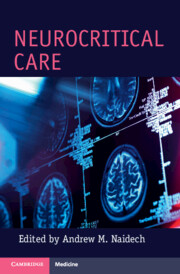Book contents
- Neurocritical Care
- Neurocritical Care
- Copyright page
- Contents
- Contributors
- 1 Introduction
- 2 Intracranial Pressure Monitoring and Management
- 3 Disorders of Temperature Regulation
- 4 Approach to Neuroimaging of the Brain, Vessels, and Cerebral Edema
- 5 Airway and Ventilator Management of the Neurologically Critically Ill Patient
- 6 Neurocritical Care Pharmacology
- 7 Intracerebral Hemorrhage
- 8 Correction of Coagulopathy
- 9 Subarachnoid Hemorrhage
- 10 Subdural Hematoma
- 11 Critical Care Management of Neurotrauma
- 12 Critical Care Management before and after Open and Intravascular Procedures
- 13 Shared Decision-Making in the Neuro-ICU
- 14 Status Epilepticus and EEG Monitoring
- 15 Evaluation of the Comatose Patient and Overview of the Brain Death Examination
- Index
- References
15 - Evaluation of the Comatose Patient and Overview of the Brain Death Examination
Published online by Cambridge University Press: 19 May 2022
- Neurocritical Care
- Neurocritical Care
- Copyright page
- Contents
- Contributors
- 1 Introduction
- 2 Intracranial Pressure Monitoring and Management
- 3 Disorders of Temperature Regulation
- 4 Approach to Neuroimaging of the Brain, Vessels, and Cerebral Edema
- 5 Airway and Ventilator Management of the Neurologically Critically Ill Patient
- 6 Neurocritical Care Pharmacology
- 7 Intracerebral Hemorrhage
- 8 Correction of Coagulopathy
- 9 Subarachnoid Hemorrhage
- 10 Subdural Hematoma
- 11 Critical Care Management of Neurotrauma
- 12 Critical Care Management before and after Open and Intravascular Procedures
- 13 Shared Decision-Making in the Neuro-ICU
- 14 Status Epilepticus and EEG Monitoring
- 15 Evaluation of the Comatose Patient and Overview of the Brain Death Examination
- Index
- References
Summary
An acutely comatose patient is a medical emergency that requires rapid evaluation and initiation of management of the underlying cause, whether it is due to a primary neurologic insult or secondary to a serious medical condition. Often, the most important details are obtained from a direct witness to the event that can provide information about the events leading up to the presentation and the patient’s medical history and medication usage. The physical examination provides clues to help localize the region of the central nervous system affected, helping to narrow the differential diagnosis. Diagnostic testing is tailored to the medical history and examination. Regardless of the ultimate cause, prompt initiation of treatment is imperative to provide the patient the best opportunity to recover. The diagnosis of brain death is a clinical diagnosis, and should be completed in a structured, stepwise manner. Ancillary testing should only be obtained if the clinical examination is unable to be fully completed.
- Type
- Chapter
- Information
- Neurocritical Care , pp. 295 - 317Publisher: Cambridge University PressPrint publication year: 2022



